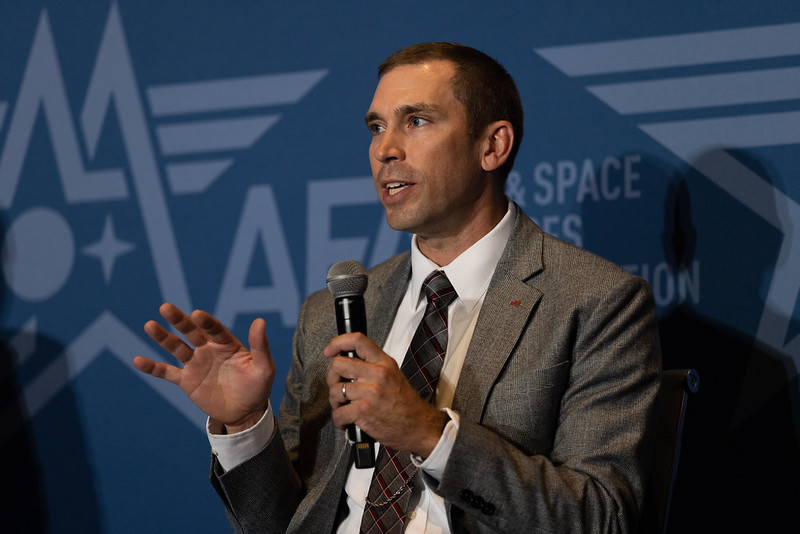Derek Tournear, director of the Space Development Agency, has made it his mission to spearhead innovation and change in the Pentagon’s approach to space acquisition. In a recent LinkedIn post, he doubled down on that commitment to “constructive disruption”—and pushed back on what he said was internal criticism of his style.
“Change is hard; change is necessary. And nothing fights change like the paralyzing behavior of going along to get along,” Tournear said in the post.
SDA and Tournear have prioritized speed in acquisition over performance, preferring to deliver proven capabilities faster rather than waiting for systems that meet DOD requirements.

Tournear stressed that this transformation sometimes necessitated someone willing to assume the role of the “bad cop.”
“Recently, I was told to stop playing the role of ‘bad cop’ on behalf of the Space Development Agency and our mission. It was suggested that I might damage relationships among my peers,” Tournear wrote, without specifying who told him to do so.
Voicing his frustration with inefficient procedures, Tournear pledged that he would continue to “be a ‘Maverick,’ a ‘wild card,’ and a ‘bad cop’ if it helps SDA meet its mission and serve the warfighter.”
Tournear’s post was applauded by former Air Force chief software officer Nicolas M. Chaillan, who commented that “If you’re liked by 100 [percent], you’re not doing your job.”
Chaillan himself authored a candid Linkedin post in 2021 when he quit his Air Force job, citing the lack of funding for crucial technologies in the joint all-domain command and control (JADC2) as the tipping point for his resignation.
Like Tournear, Chaillan also described facing resistance within the Pentagon bureaucracy as he pushed for a faster development approach. Within software and IT, Chaillan championed DevSecOps, which involves breaking development into smaller pieces and rapid updates, in contrast to slower traditional methods like “waterfall” development.
Similarly, in 2022, Preston Dunlap, the first-ever Chief Architect Officer of the Department of the Air Force, garnered attention with another LinkedIn post highlighting the need for systemic changes to the Pentagon bureaucracy.
Many of his critiques and proposed solutions echo the fast-moving approach both Tournear and Chaillan favor.
Dunlap outlined four steps to overcome bureaucratic obstacles:
- shock the system
- change the way acquisitions are carried out
- prioritize timely delivery
- overcome obstacles in project development
In his post, Dunlap also advocated for transforming the Pentagon’s acquisition process by embracing commercial technologies, concentrating on outcomes, involving external innovators, and adopting a rapid pace.
Of the three, Tournear is the only one still within the department, and SDA is pushing forward with its approach for at least the next several years as it builds out the Proliferated Warfighter Space Architecture (PWSA), a massive planned satellite constellation in low-Earth orbit.
In September, SDA launched 13 satellites as part of Tranche 0 for that constellation. This was the agency’s second successful launch, with plans for a third launch before the end of 2023.
While Tranche 0 is a test phase for the PWSA, Tranche 1 launches are planned for fall 2024, and Tranche 2 in 2026. Contracts for Tranche 1 have already been awarded, and the agency started handing out deals for the Tranche 2 Transport Layer this summer, tapping Northrop Grumman and Lockheed Martin for 36 tactical communications satellites each.
Tournear’s goal with PWSA is to deter China and Russia from shooting down satellites by making it more costly to destroy a single satellite than to build one.
To make this strategy work, the SDA aims to keep satellite costs under $15 million each while improving their performance, much like how cell phones have advanced without a significant increase in price over time. The latest Tranche 2 contract was worth $1.55 billion, with an average cost of about $21.5 million per satellite.
All told, SDA has awarded contracts or launched more than 270 satellites, compared to roughly 80 total in the Space Force’s entire inventory.
Proliferated Warfighter Space Architecture
| TRANCHE | LAYER | # OF SATELLITES | CONTRACTORS |
|---|---|---|---|
| 0 | Transport | 20 | York Space Systems, Lockheed Martin |
| Tracking | 8 | SpaceX, L3Harris | |
| 1 | Transport | 126 | York Space Systems, Lockheed Martin, Northrop Grumman |
| Tracking | 35 | L3Harris, Northrop Gumman, Raytheon | |
| Demonstration and Experimentation System | 12 | York Space Systems | |
| 2 | Transport | 72 | Northrop Grumman, Lockheed Martin |
| Transport | 100 | TBA | |
| Transport | 44 (approx.) | TBA | |
| Tracking | 52 (approx.) | TBA | |
| Demonstration and Experimentation System | 20 (approx.) | TBA |
